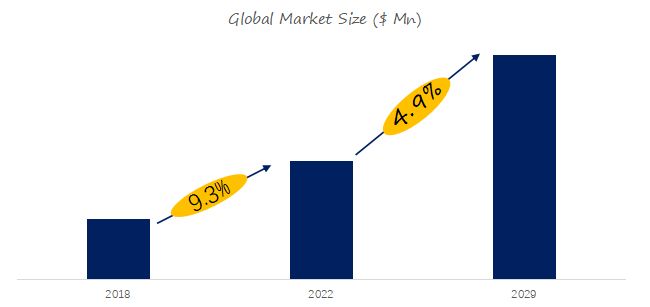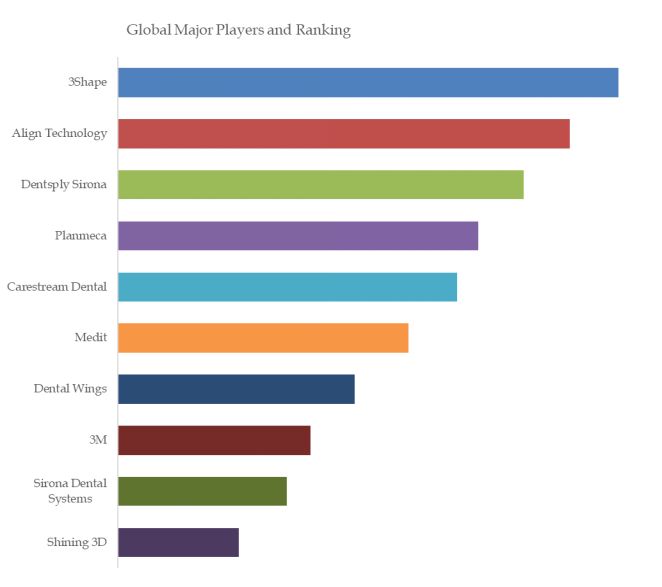Digital Dental Intraoral Scanner Market Trends: the global market size is projected to reach USD 1.86 billion by 2029
A digital dental intraoral scanner is a device used by dentists and orthodontists to capture highly detailed 3D images of a patient's teeth and oral structures. It is a modern alternative to traditional dental impressions, which often involve messy materials and can be uncomfortable for patients.
According to the new market research report “Digital Dental Intraoral Scanner - Global Market Share and Ranking, Overall Sales and Demand Forecast 2024-2030”, published by QYResearch, the global Digital Dental Intraoral Scanner market size is projected to reach USD 1.86 billion by 2029, at a CAGR of 4.9% during the forecast period.
- Global Digital Dental Intraoral Scanner MarketSize(US$ Million), 2018-2029

Source: QYResearch, "Digital Dental Intraoral Scanner - Global Market Share and Ranking, Overall Sales and Demand Forecast 2024-2030”
- Global Digital Dental Intraoral Scanner Top10Players Ranking and Market Share (Ranking is based on the revenue of 2022, continually updated)

Source: QYResearch, "Digital Dental Intraoral Scanner - Global Market Share and Ranking, Overall Sales and Demand Forecast 2024-2030”
According to QYResearch Top Players Research Center, the global key manufacturers of Digital Dental Intraoral Scanner include 3Shape, Align Technology, Dentsply Sirona, Planmeca, Carestream Dental, etc. In 2022, the global top four players had a share approximately 31.0% in terms of revenue.
Market Drivers:
- Advancements in technology: The continuous advancements in digital imaging technology have significantly improved the capabilities and accuracy of intraoral scanners. These scanners now offer higher resolution, faster scanning speeds, and improved software algorithms, resulting in more precise and detailed digital impressions.
- Growing demand for digital dentistry: There is a growing demand for digital solutions in dentistry due to the numerous benefits they offer. Digital dental intraoral scanners are a key component of the digital workflow, allowing for efficient and accurate treatment planning, digital smile design, and the fabrication of custom restorations.
- Improved patient experience: Digital dental intraoral scanners provide a more comfortable and convenient experience for patients compared to traditional dental impressions. Patients no longer need to endure the discomfort and gag reflex associated with impression materials, making dental visits more pleasant and reducing patient anxiety.
- Increased accuracy and precision: Digital scanning eliminates the potential for errors and inaccuracies that can occur with traditional impressions. The high-resolution images captured by intraoral scanners provide dental professionals with precise and detailed information, leading to more accurate treatment planning and better fitting restorations.
- Time and cost savings: Digital intraoral scanners streamline the treatment process by eliminating the need for physical impressions and reducing the turnaround time for restorations. This not only saves time for both dental professionals and patients but also reduces costs associated with materials and shipping.
- Integration with digital workflows: Digital dental intraoral scanners seamlessly integrate with other digital technologies such as computer-aided design and computer-aided manufacturing (CAD/CAM) systems. This allows for efficient digital workflows, enabling the design and fabrication of custom restorations with greater precision and efficiency.
- Increasing adoption of cosmetic dentistry and orthodontics: The growing demand for cosmetic dentistry procedures, such as veneers and aligners, as well as orthodontic treatments, has driven the adoption of digital dental intraoral scanners. These scanners play a crucial role in treatment planning and monitoring progress in cosmetic and orthodontic cases.
Restraint:
The initial investment cost for digital dental intraoral scanners can be relatively high compared to traditional impression materials and trays. This cost can be a barrier for some dental practices, especially smaller ones or those with limited budgets. Additionally, there may be ongoing costs for software updates, maintenance, and training.
Opportunity:
- Increasing adoption of digital dentistry: The dental industry is undergoing a digital transformation, with an increasing number of dental practices adopting digital technologies. This presents a significant opportunity for digital dental intraoral scanners, as they are a fundamental component of the digital workflow. As more dentists and orthodontists embrace digital dentistry, the demand for intraoral scanners is expected to rise.
- Growing awareness and acceptance among patients: Patients are becoming more aware of the benefits of digital dentistry, including the use of intraoral scanners. They appreciate the improved comfort, accuracy, and efficiency that digital scanning offers compared to traditional impressions. As patient education and awareness continue to increase, there is an opportunity for dental practices to leverage this demand and attract more patients by offering digital scanning services.
- Expansion of cosmetic dentistry and orthodontics: The cosmetic dentistry and orthodontics markets are experiencing significant growth, driven by increasing consumer demand for aesthetic dental treatments and orthodontic solutions. Digital dental intraoral scanners play a crucial role in treatment planning and monitoring progress in these cases. As the demand for cosmetic dentistry and orthodontics continues to rise, the market for intraoral scanners is expected to expand accordingly.
- Technological advancements: The continuous advancements in digital imaging technology and software algorithms are opening new opportunities for digital dental intraoral scanners. These advancements are improving the accuracy, speed, and ease of use of intraoral scanners, making them more appealing to dental professionals. Additionally, the integration of artificial intelligence (AI) and machine learning into intraoral scanners has the potential to further enhance their capabilities and provide valuable insights for treatment planning.
- Emerging markets: The adoption of digital dental intraoral scanners is still relatively low in certain emerging markets. However, as dental practices in these regions become more aware of the benefits and cost-effectiveness of digital dentistry, there is an opportunity for the market to grow. The rising disposable incomes, increasing dental tourism, and advancements in healthcare infrastructure in emerging markets are factors that contribute to the potential growth of the intraoral scanner market in these regions.
About The Authors
Hongjichi - Lead Author
Email: hongjichi@qyresearch.com
About QYResearch
QYResearch founded in California, USA in 2007.It is a leading global market research and consulting company. With over 16 years’ experience and professional research team in various cities over the world QY Research focuses on management consulting, database and seminar services, IPO consulting, industry chain research and customized research to help our clients in providing non-linear revenue model and make them successful. We are globally recognized for our expansive portfolio of services, good corporate citizenship, and our strong commitment to sustainability. Up to now, we have cooperated with more than 60,000 clients across five continents. Let’s work closely with you and build a bold and better future.
QYResearch is a world-renowned large-scale consulting company. The industry covers various high-tech industry chain market segments, spanning the semiconductor industry chain (semiconductor equipment and parts, semiconductor materials, ICs, Foundry, packaging and testing, discrete devices, sensors, optoelectronic devices), photovoltaic industry chain (equipment, cells, modules, auxiliary material brackets, inverters, power station terminals), new energy automobile industry chain (batteries and materials, auto parts, batteries, motors, electronic control, automotive semiconductors, etc.), communication industry chain (communication system equipment, terminal equipment, electronic components, RF front-end, optical modules, 4G/5G/6G, broadband, IoT, digital economy, AI), advanced materials industry Chain (metal materials, polymer materials, ceramic materials, nano materials, etc.), machinery manufacturing industry chain (CNC machine tools, construction machinery, electrical machinery, 3C automation, industrial robots, lasers, industrial control, drones), food, beverages and pharmaceuticals, medical equipment, agriculture, etc.

English
Simon Lee

English
Hitesh

Chinese
Damon

Japanese
Tang Xin

Korean
Sung-Bin Yoon
Competition
Key players, new entrants,acquisitions, mergers and expansions,development trends and challenges.
Industry Analysis
Rawmaterial, application, product type, demand,supply,downstream, supply chain etc.
Market Size
Capacity, production, sales, revenue, price, cost etc.
Customized Information
We can offer customized survey and information to meet ourclient's need.